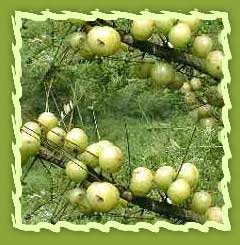
Herbal Amla is a small to medium sized deciduous tree, 8-18 m in height with thin light grey bark exfoliating in small thin irregular flakes; leaves simple, very many, subsessile, closely set along the branchlets, distichous, light green having the appearance of pinnate leaves. Flowers of Herbal Amla or Indian Gooseberry are greenish yellow, in axillary fascicles, unisexual, males numerous on short slender pedicels, females few, subsessile, ovary 3-celled; Amla fruits globose, fleshy, pale yellow with six obscure vertical furrows enclosing 6 trigonous seeds in 2-seeded 3 crustaceous cocci.
Chemical Constituents
The major amino acids present in herbal amla are; alanine, aspartic acid, glutamic acid, lysine, and proline, analysis of fresh fruit pulp gave moisture, protein, fat carbohydrates fibre, minerals, iron, niacin, and vitamin fruit ash contains; chromium and copper.
Cosmetic Uses
Amla or Indian Gooseberry has one of the purest forms of natural Vitamin C, 20 times higher than orange juice. Herbal amla in forms of herbal powder and amla oil nourishes the hair, thickens and darkens it. Amla fruit is said to penetrate the scalp and strengthen hair at its root, to stop and reverse abnormal hair loss and to promote stronger, healthier new growth. Herbal Amla is also an excellent conditioning herb.
The Amla fruit yields an oil that has been used for centuries in Ayurvedic medicine to treat the hair and scalp. Amla fruit is said to penetrate the scalp and strengthen hair at its root, to stop and reverse abnormal hair loss and to promote stronger, healthier hair growth. Amla or Indian Gooseberry is also an excellent conditioner to use as a hot oil treatment. Amla oil and amla powder is used in shampoos, conditioning rinses, hair pomades and oil treatments. It can also be used in combination with Brahmi oil to strengthen the hair and add body. Amla powder is good in skin disorders, Respiratory infections and Premature aging. The dried amla fruit is detergent and is widely used as shampoo. These are so many known applications of amla tree and its products that many companies dealing in traditional medicines use amla fruit for preparing different formulations for treating several diseases, as health tonic etc.
An Ancient farmula with therapeutis properties designed to penetrate hair shaft and naurish scalp. Indian Gooseberry contains powerful, preventive, protective and corrective qualities. Amla powder is useful in aloepecia and corrects split ends and prevents dryness. Amla encourages blood supply to the scalp.
Medicinal Uses
The root bark is astringent, and is useful in ulcerative stomatitis and gastrohelcosis. The bark is useful in gonorrhoea, jaundice, diarrhoea and myalgia. The leaves are useful in conjunctivitis, inflammation, dyspepsia, diarrhoea and dysentery. The fruits are sour, astringent, bitter, acrid, sweet, cooling, anodyne, ophthalmic, carminative, digestive, stomachic, laxative, alterant, alexeteric, aphrodisiac, diuretic, antipyretic, tonic and trichogenous. They are useful in vitiated conditions of tridosa; diabetes, cough, asthma, bronchitis, cephalalgia, ophthalmopathy, dyspepsia, colic, flatulence, hyperacidity, peptic ulcer, erysipelas, skin diseases, leprosy, haematemesis, inflammations, anaemia, emaciation, hepatopathy, jaundice, strangury, diarrhoea, dysentery, haemorrhages, leucorrhoea, menorrhagia, cardiac disorders, intermittent fevers and greyness of hair.
TIPS
|
No comments:
Post a Comment